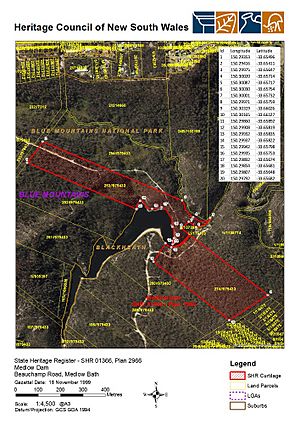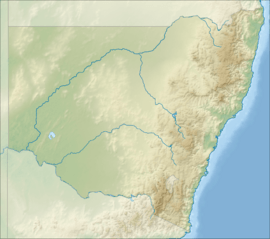Medlow Dam facts for kids
Quick facts for kids Medlow Dam |
|
|---|---|

Heritage boundaries
|
|
|
Location in New South Wales
|
|
| Country | Australia |
| Location | Beauchamp Road, Medlow Bath, City of Blue Mountains, New South Wales |
| Coordinates | 33°39′30″S 150°17′57″E / 33.6583°S 150.2993°E |
| Purpose | Potable water supply |
| Status | Operational |
| Opening date | 1907 |
| Owner(s) | Sydney Water |
| Dam and spillways | |
| Type of dam | Arch dam |
| Impounds | Adams Creek |
| Height (foundation) | 20.6 metres (68 ft) |
| Length | 38.2 metres (125 ft) |
| Width (crest) | 1.1 metres (3 ft 7 in) |
| Dam volume | 1 thousand cubic metres (35×103 cu ft) |
| Spillways | 1 |
| Spillway type | Uncontrolled |
| Spillway capacity | 22 cubic metres per second (780 cu ft/s) |
| Reservoir | |
| Creates | Medlow Bath Reservoir |
| Total capacity | 304.5 megalitres (10.75×106 cu ft) |
| Active capacity | 297 megalitres (10.5×106 cu ft) |
| Catchment area | 4.8 square kilometres (1.9 sq mi) |
| Surface area | 5 hectares (12 acres) |
| Official name | Medlow Dam; Medlow Bath Dam; Lake Medlow Dam; Adams Creek Dam; Medlow Bath Reservoir |
| Type | State heritage (built) |
| Designated | 18 November 1999 |
| Reference no. | 1366 |
| Type | Water Supply Reservoir/ Dam |
| Category | Utilities - Water |
| Builders | NSW Department of Public Works |
Medlow Dam is a special heritage-listed dam in the Blue Mountains region of New South Wales, Australia. It is located on Adams Creek in Medlow Bath. The dam was built in 1907 by the NSW Department of Public Works.
Its main job is to provide clean drinking water for the upper Blue Mountains area. The lake created by the dam is called Medlow Bath Reservoir. You might also hear it called Medlow Bath Dam, Lake Medlow Dam, or Adams Creek Dam. The dam is owned by Sydney Water. It was added to the New South Wales State Heritage Register on 18 November 1999 because of its historical importance.
Contents
History of Medlow Dam
Medlow Dam is a unique concrete dam with a thin, curved wall. It was built in 1907 by the Public Works Department of NSW. Its main purpose was to supply water to nearby towns. It might also have been used for its beautiful appearance.
In 1940, the local council took control of the dam. Later, in 1980, it was handed over to the Metropolitan Water Sewerage and Drainage Board. Medlow Bath first received water from the dam in 1907. Later, water supply was extended to Blackheath, Megalong, and Mount Victoria.
The "Wade Dams" Design
Medlow Dam is part of a group of dams known as the "Wade Dams." These dams were built in the late 1800s and early 1900s. They were designed by the NSW Public Works Department, often under the guidance of Mr. L. A. B. Wade.
These dams were special because they used thin, curved concrete walls. This design was quite new and daring at the time. Many engineers were worried about how strong these thin walls would be.
World-Leading Dam Design
Medlow Dam and a similar dam in Lithgow were considered world leaders in dam design. They are still studied by engineers today because of their unusually thin walls.
Mr. C. W. Darley, a top engineer, started the idea of building these types of dams in Australia. Mr. L. A. B. Wade then designed and oversaw the building of dams like Medlow, Lithgow No. 2, and Katoomba.
These dams were made of plain concrete, without steel reinforcement. Their curved shape helped them stand strong against the water pressure. Engineers at the time treated them like parts of a strong cylinder. This simple idea worked well, even though it seemed risky.
Engineering Controversy
The design of these dams caused a lot of debate among engineers. An earlier similar dam in California, built in 1884, also faced criticism. Many experts believed that such thin walls wouldn't be safe.
In 1909, engineers from around the world discussed these dams. Some comments included:
- Walter Hunter said he would be "a little nervous" sleeping downstream of such a dam.
- Mr. C. E. Jones felt "very much concerned" for the engineers in charge.
- Mr. Reginald E. Middleton "admired the pluck" of the designers.
- Col. J. Pennycuick noted that engineers usually didn't have "the courage of their opinions" until these NSW dams were built.
Even a famous engineer, Sir Alexander Binnie, found the thin walls "blood-curdling." However, he admitted that the dams were built and working. He challenged mathematicians to explain how such thin walls could handle the stress.
The main reason for this bold design was money. Mr. Darley explained that small towns could not afford expensive, thick dams. So, it was a choice between building a cheaper dam or having no water supply at all.
What Medlow Dam Looks Like
Medlow Dam is a small dam that uses a thin, curved concrete wall. It can hold about 304.5 million litres of water. The dam wall is about 20.6 metres tall.
The wall is curved with a radius of 18.5 metres and is 38.2 metres long. At the top, the wall is only 1.1 metres thick. The dam is still used every day for its original purpose. It relies on the strength of the concrete and the valley sides to stay stable.
Next to the dam, there is a small pumping corrugated iron shed. In 1993, this shed contained three important pumps. Two of them were from 1927, and the third was from the mid-1930s.
Current Condition
As of 2008, Medlow Dam was in good condition and fully working.
Changes Over Time
- 1993: White mineral deposits (calcite) were cleaned off the dam's downstream side using high-pressure water.
- 2008: A part called a trunnion winch was replaced. The old winch was moved to a nearby carpark for people to see and learn about.
Why Medlow Dam is Special
Medlow Dam is very important for several reasons:
Historical Significance
Medlow Dam was the first water supply dam built for the Upper Blue Mountains. It is a key example of the "Wade" series of dams. These dams were built in NSW between the 1890s and early 1900s to supply water to country towns. They all used the special concrete arch wall design.
The dam's design came from the work of two leading Australian engineers, L. A. B. Wade and C. W. Darley. Medlow Dam was a world leader in developing thin-walled concrete arch dams. It caused a lot of discussion when it was finished. It was said to have the thinnest wall of any similar dam in the world at that time. It is still used as an example in engineering textbooks. The dam's completion was a big step in giving a reliable water supply to Medlow Bath, Blackheath, and nearby areas.
Design and Beauty
Medlow Dam is a simple and attractive structure. It is located in a beautiful natural setting. It is an excellent example of a thin-walled concrete arch dam. The thinness of its walls helps people appreciate the clever engineering behind its design.
Community and Engineering Value
Medlow Dam is important to engineers. It is listed in the Engineering Heritage Register of NSW (1994). It is also important to the community of NSW, as shown by its inclusion in the National Trust of Australia (NSW) Register (1985).
Research Potential
Medlow Dam has the thinnest concrete arch wall ever built in Australia. It provides ongoing information about how this type of dam construction performs over a long time. This makes it valuable for future engineering studies.
Rarity and Uniqueness
Medlow Dam was the first water supply dam built for the Upper Blue Mountains. When it was built, it was a world leader in thin-walled concrete arch dams. It had the thinnest wall of any similar dam anywhere.
Representative Example
Medlow Dam is a great example of the "Wade" series of dams. These dams were built in NSW for country towns using thin concrete arch walls. Medlow Dam stands out as a particularly notable example within this group.
Engineering Award
The dam received a Historic Engineering Marker from Engineers Australia. This award is part of their Engineering Heritage Recognition Program.


